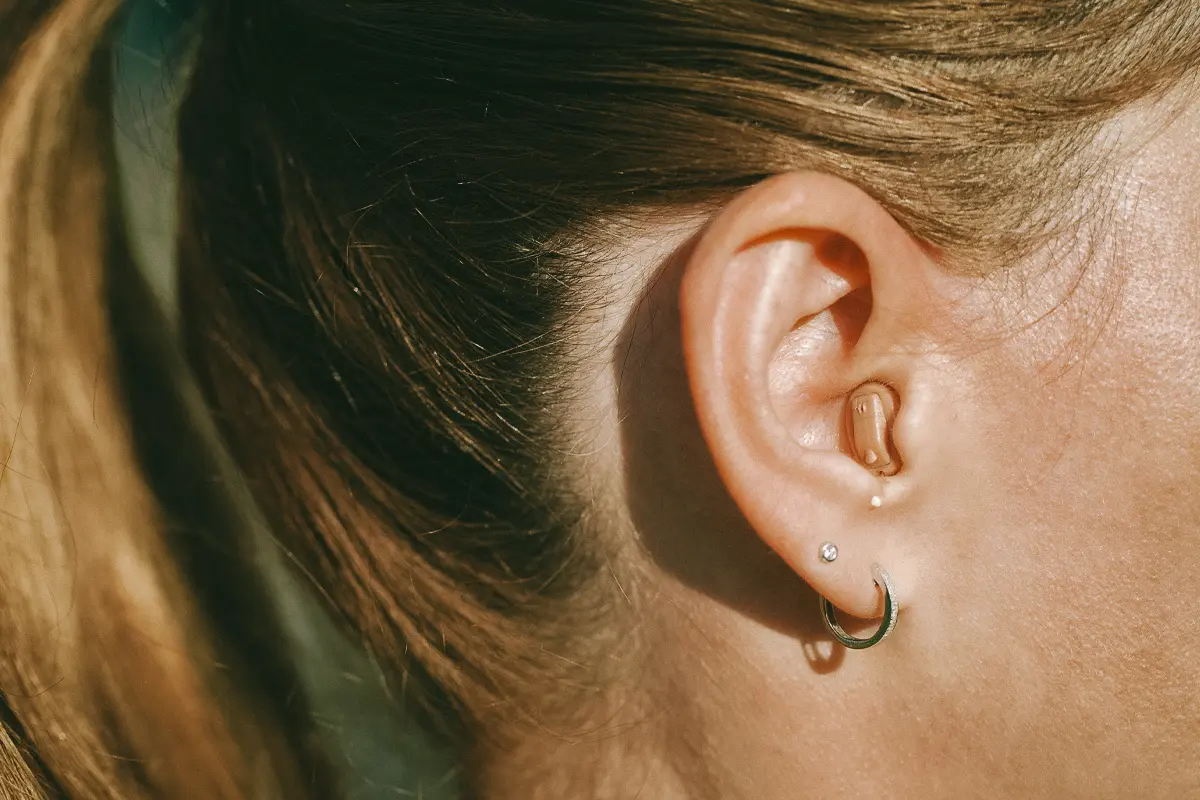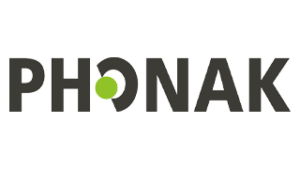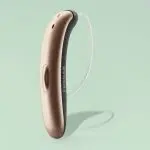Table of Contents
- We spent more than 7,500 hours researching dozens of hearing aids and using a 25-question checklist to identify standout contenders. Then, our team personally tested 27 of the most popular and highly rated devices.
- We’ve interviewed 26 real hearing aid users and consulted with 17 experts to learn which features are important when choosing a hearing aid.
- We conducted a thorough and hands-on testing process, evaluating setup and adjustment, comfort and fit, sound quality and performance, battery life and charging, ease of use, and support.
- Learn more about how we tested Phonak hearing aids.
Key takeaways
- Phonak offers advanced sound processing technology, a wide range of models for different levels of hearing loss, and strong Bluetooth connectivity features.
- Phonak hearing aids typically cost between $1,300–$6,500 per pair. While coverage by insurance varies, Medicare does not cover hearing aids.
- All Phonak hearing aids require a prescription and hearing test from an audiologist.
- A standout feature of Phonak hearing aids is the AutoSense OS technology, which automatically adjusts to your environment without manual adjustments.
Untreated hearing loss is linked to an increased risk of depression, cognitive decline, and social isolation, making hearing health critical to mental health. Research shows that people with hearing loss are up to 47 percent more likely to experience symptoms of depression than those without hearing impairment.
But treating your hearing loss with hearing aids from brands like Phonak can help reduce feelings of depression and isolation. Phonak is a prescription hearing aid that can only be purchased, fitted, and customized through an audiologist.
While the popularity of over-the-counter (OTC) hearing aids is on the rise, prescription devices can provide a more powerful and personalized product that can treat a wider range of hearing loss. Our survey of 600 recent hearing aid shoppers found that nearly 27 percent of respondents purchased prescription hearing aids to treat their hearing loss. Read on to learn if Phonak is the best hearing aid for you.
Phonak Audéo Lumity highlights
Our experience with Phonak Audéo Lumity
The Phonak Audéo Lumity is a high-tech hearing aid designed for those with mild to profound hearing loss. It offers advanced sound processing, Bluetooth connectivity, and health-tracking. The innovative features and customization options reflect its higher price point.
Who may like it: Tech-savvy users seeking a customizable, high-performance hearing aid with automatic sound adjustments.
Who may want to avoid it: Those on a budget looking for a more affordable hearing aid option.
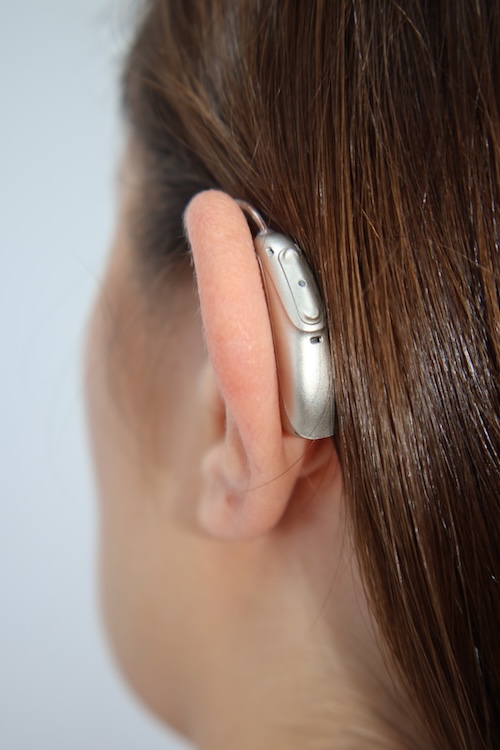
Insights from our Phonak Audéo Lumity testers
The Phonak Audéo Lumity is a feature-packed receiver-in-canal (RIC) hearing aid designed for people with mild to profound hearing loss. We appreciate the advanced technology in this model, which includes Phonak’s AutoSense feature. AutoSense automatically adjusts your settings based on your environment, allowing for automatic transitions in different sound settings without you having to manually change the hearing aid mode. The Audéo Lumity also comes with SmartSpeech technology, designed to enhance speech clarity in noisy and quiet environments, making conversations easier and more natural.
While we appreciate the automatic adjustments, our testers say making manual adjustments with the multi-function button on the hearing aid is intuitive. They appreciate its placement, which does not interfere with the fit or positioning of the hearing aid. However, the button is small, which could make it difficult to handle for some. This button controls volume, program changes, Bluetooth pairing, and allows you to answer or reject hands-free calls.
Alternatively, you can make adjustments through the MyPhonak app. It allows for all of the adjustments of the multi-function button plus health metric tracking, such as wear time, steps, and heart rate, which makes it a comprehensive tool for anyone who wants to monitor their activity levels. The app also provides remote support from an audiologist, access to how-to videos, an FAQ section, and voice assistant functionality. Our testers appreciate the app’s many features and find it straightforward to navigate.
From our tester
“The MyPhonak app is very well designed and feature rich. It has a lot of features, but the way it’s designed it’s not overwhelming.”
Our testers say this hearing aid is comfortable and ergonomic. The device is waterproof The device can be submerged in water for a long time and still function properly. and sweatproof, with models available in 11 color options. It takes approximately three hours to fully charge, which provides up to 16 hours of battery life in a single charge, including four hours of Bluetooth streaming. The charging case is portable, which allows you to charge the hearing aids up to three times on the go. This makes it convenient for travel or extended periods away from a power source. The charging case receives high marks from our testers, who like the strong magnetic connection that ensures the hearing aids “snap right into place.”
The starting cost per pair ranges from $2,600–$6,500, depending on the supplier, power level, and customizations. If you need a hearing aid that adjusts to your sound environment, streams seamlessly, and tracks your health, you may want to consider the Audéo Lumity. However, if this price is out of your range, you may want to explore more affordable options in Phonak’s lineup.
Phonak Lyric highlights
Our experience with Phonak Lyric
The Phonak Lyric is a unique, invisible-in-the-canal (IIC) hearing aid made for people with mild to severe hearing loss. It stays in the ear constantly for several months, eliminating the need for daily removal or charging. Due to its deep placement in the ear canal, it’s designed to offer a natural hearing experience. However, it lacks Bluetooth connectivity and requires regular visits to a specialist for replacement. While we haven’t tested this hearing aid because of how it’s placed in the ear, other Phonak models we test have had good quality sound, background noise reduction, and advanced tech.
Who may like it: Those seeking a completely invisible, hassle-free hearing aid that offers natural sound quality.
Who may want to avoid it: Users who want Bluetooth streaming or prefer hearing aids that offer user control over settings.
Insights from our Phonak Lyric testers
The Phonak Lyric stands out as one of the most discreet hearing aids on the market. It is specifically designed for people with mild to severe hearing loss. Unlike traditional hearing aids that require daily maintenance or removal, the Lyric is placed deep within the ear canal by an audiologist and remains there for months at a time. It’s completely invisible, making it an ideal option for those who want their hearing aids to remain out of sight.
One of the Lyric’s key features is how it uses the ear’s natural anatomy to amplify sound, rather than relying on external microphones. This deep placement near the eardrum is designed to reduce occlusion occlusion effect: When an object (like a hearing aid) fills the outer portion of the ear canal that causes you to perceive a booming, hollowing echo-like sound. (booming or echoing sounds), which can happen with traditional hearing aids. Additionally, while most hearing aids capture and process sound from outside the ear, Lyric’s positioning allows it to collect sound more naturally, which users report enhances the clarity of conversations and environmental sounds.
My Lyric patients prefer the sound quality leaps and bounds above the sound quality they get with digital hearing aids.
Rachel Cook, audiologist at HearingUp
One of the most notable benefits of the Lyric is its convenience. The device does not need to be recharged, turned on or off, or removed for regular activities like sleeping or exercising. The battery lasts for several months, after which you will need to visit your audiologist for a replacement. While older versions of the Lyric required multiple visits per year to replace the devices, Phonak recently received FDA clearance for some users to self-replace their devices, which may reduce the number of appointments. However, despite these improvements, the Lyric is not waterproof, meaning it should not be fully submerged during underwater activities such as swimming.
There are a few downsides to consider with the Lyric model. First, it lacks Bluetooth connectivity, so it can’t be paired with smartphones or other devices to stream music or take phone calls directly. Second, the Lyric is sold via an annual subscription plan, which costs between $3,000–$6,000 per year. This ongoing expense is significantly more of an investment over time than other traditional prescription hearing aids on the market. Additionally, even though they come in seven sizes, people with certain ear shapes, very small ear canals, heavy earwax production, or a history of ear-related medical conditions may not be suitable candidates for this model.
“I do not recommend Lyric if you travel a lot because if something happens and you’re not there to get a replacement, you have to wait until you come back or find a Lyric provider where you are visiting,” Cook says.
Despite these considerations, the Phonak Lyric offers a unique and innovative approach to hearing care. Its discreet design, long-lasting battery, and natural sound quality may make it an attractive option for those who prioritize invisibility and convenience. The Lyric also has potential benefits for users with tinnitus Tinnitus is when a person hears ringing, buzzing, or other noises in the ear. It is often associated with hearing loss. , as its around-the-clock use can help ease symptoms—even during sleep, when tinnitus can negatively impact sleep quality.
Phonak Slim highlights
Our experience with Phonak Slim
The Phonak Slim offers a discreet design and great audio quality. Its slim fit makes it one of the most comfortable BTE hearing aids our team has tested, while its advanced sound technology provides one of the best sound quality experiences we’ve had.
Who may like it: Those who prioritize discreet design, great sound quality, and Bluetooth streaming in a hearing aid.
Who may want to avoid it: People seeking a lower-cost option or prefer traditional battery-powered models.
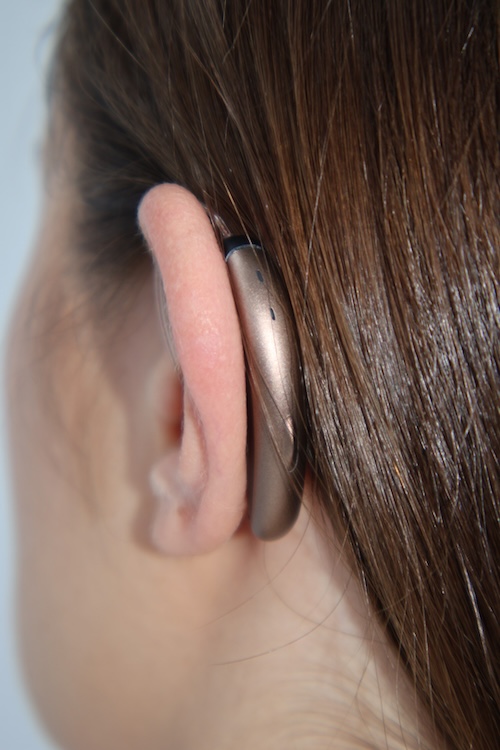
Insights from our Phonak Slim testers
The Phonak Slim is a thin and modern behind-the-ear (BTE) hearing aid that combines high-tech features and a contoured design. One of the Slim’s standout features is its ergonomic fit, which our testers appreciate and say is “very comfortable.” The slim design rests behind the ear, allowing for plenty of room for glasses or oxygen tubing if necessary. But this model should appeal to anyone who wants an unobtrusive design.
From our tester
“Very comfortable—probably the best fit I’ve tried. Very ergonomic and slimly fits behind the ear.”
This model is part of Phonak’s Lumity family, which is known for its advanced features. Designed for people with mild to severe hearing loss, the Slim comes in two power levels, the L90 and L70. Both feature AutoSense OS 5.0, which uses machine learning to automatically adjust to different sound environments. Whether in a noisy restaurant or a quiet room, the hearing aid adapts to your surroundings without requiring manual adjustments.
The Slim also includes SmartSpeech technology, which is designed to enhance the speech clarity of the person speaking while reducing background noise. This makes it ideal for social settings or environments with challenging background noise.
Our testers have given high praise to the Slim’s audio. They say the sound quality and clarity is the best they’ve tested so far, highlighting there is hardly any background noise, tinny sounds, or sound distortion when using the device. One tester says that upon first use, the sound simply was amplified, highlighting the purity of sound.
Like the Audéo Lumity, the Slim has a rechargeable battery that provides up to 16 hours of use on a single charge, including four hours of streaming. The portable charging case charges the hearing aids up to three times with three hours per charge.
Like other models in the Lumity family, the Slim features Bluetooth connectivity, which allows for hands-free calling and streaming with both iPhones and Android devices. It also includes telecoil A small copper wire in your hearing aid serves as a receiver, allowing you to connect to audio through a loop system often found in public facilities, including places of worship and public transportation. technology, which connects the hearing aid to public sound systems in places like theaters or airports.
The IP68 water-resistant rating ensures that wearers can shower and sweat, making it good for people with active lifestyles.
Other Phonak models
In addition to the Phonak models we’ve covered, Phonak recently launched its Infinio series, which is currently in our testing queue and includes some of the brand’s newest and most advanced features. The brand says Infinio hearing aids have improved sound processing, enhanced SmartSpeech technology, and better battery performance. These models are designed to provide clearer speech recognition and a more natural listening experience, even in challenging environments.
The Infinio models typically range from $2,500–$8,000 (or more) per pair, depending on customization and specific features. Innovations in this series include enhanced Bluetooth connectivity, which allows pairing with multiple devices at once, and AI-driven sound adjustments that automatically adapt to your surroundings in real time to offer a more personalized hearing experience.
How much do Phonak hearing aids cost?
Phonak hearing aids generally fall into the higher price range, with most models costing between $1,300–$6,500 per pair (or more), depending on the model and features. For example, the Naída Paradise, designed for users with severe to profound hearing loss, can cost up to $6,000 per pair, while the more basic Bolero Marvel starts at around $2,100. Phonak’s prices are comparable to other premium hearing aid brands like Oticon and Starkey, both of which offer high-end features like Bluetooth streaming, automatic sound adjustment, and telecoil compatibility.
Are Phonak hearing aids covered by insurance?
Phonak hearing aids may be covered by private insurance, but coverage varies widely depending on your provider and plan. While many insurance plans offer partial coverage, some only cover hearing tests and evaluations but not the hearing aids themselves. Unfortunately, Medicare does not cover hearing aids, though some Medicare Advantage (Part C) plans may offer partial coverage.
Medicaid coverage for hearing aids is available in some states, but eligibility requirements and covered services vary by location. It’s essential to check with your specific insurance provider to confirm the benefits available for hearing aids.
How to save money on Phonak hearing aids
There are several ways to save money on Phonak hearing aids. One option is to explore financial aid programs, though Phonak itself does not offer direct financial assistance. State vocational rehabilitation programs may provide assistance to eligible people. Additionally, some audiologists and hearing centers offer payment plans or financing options, allowing you to spread the cost over time. Shopping during promotions or buying refurbished models can also reduce the overall price. Finally, consider using a Flexible Spending Account (FSA) or Health Savings Account (HSA) to pay for hearing aids with pre-tax dollars, which can help you save on out-of-pocket expenses.
Phonak accessories
Phonak offers a variety of accessories designed to enhance the functionality and usability of their hearing aids. Here are some of the key accessories and their functions:
Roger Microphones
Roger On
This versatile microphone helps you hear better in noisy environments or over distances. It can be clipped onto clothing or placed on a table to transmit sound directly to the hearing aids, improving speech clarity in group conversations or meetings. Depending on the model and where you buy it, it can cost anywhere from $700–$1,500, typically on the higher end.
Roger Select
Designed for multi-speaker environments, this microphone allows users to select the direction they want to focus on during conversations. Ideal for busy social settings like restaurants, it can cost between $900–$1,300.
TV Connector
This accessory streams audio from the television directly to your Phonak hearing aids to provide clearer sound without external speakers. It works with most modern TV models and offers easy plug-and-play functionality. It costs around $250.
PartnerMic
A simple clip-on microphone that a partner or speaker can wear, PartnerMic transmits the wearer’s voice directly to your hearing aids for clearer sound in one-on-one conversations or noisy environments. It costs around $400.
RemoteControl
This small, easy-to-use remote allows users to adjust volume and program settings on their hearing aids discreetly. It’s ideal if you prefer manual control without using the smartphone app. It costs around $250.
Power Pack
An add-on to Phonak’s charging case, the Power Pack provides portable power for recharging hearing aids while on the go. This is especially useful when traveling or without access to power outlets. It costs around $100–$150.
Our testing experience
With FDA approval, the OTC hearing aid market experienced rapid growth with an influx of new companies. While this improves accessibility and helps drive down prices, it also muddies the waters. How do you know which products are trustworthy?
When choosing hearing aids to test, we survey the market, interview hearing health experts, and speak to real hearing aid users. To date, we’ve curated a list of 21 OTC models to test from nine brands: Audien, Audicus, Eargo, Go Hearing, Jabra Enhance, Lexie, Lucid, MDHearing, and Sony. We chose these brands because they have positive reputations and represent a range of prices, styles, and features.
We also tested prescription models from Oticon, Phonak, and Starkey to experience the difference between OTC and Rx (prescription) hearing aids firsthand.
The process looked like this:
Our testers try multiple devices and answer 25 questions about each. We use these answers to look for outstanding performers. For example, the clarity of the Jabra Enhance Select 200 immediately catches our testers’ attention like no other OTC hearing aid.
From our tester
“Jabra Enhance Select 200 has great sound quality for different environments. I can really tell the difference between the listening programs.”
We also look for hearing aids that demonstrate consistent quality in fundamental features, like sound clarity, setup, comfort, and ease of use. Brands that don’t meet those standards didn’t make it onto our best-of list.
No brand’s hearing aids perform flawlessly. For example, one of our testers runs into trouble right away with the MDHearing Volt: the Quick Start Guide doesn’t explain how to turn it on.
We also complete onboarding calls with brand audiologists and talk with customer service representatives over the phone and through chat modules to accurately replicate the buying process and evaluate post-purchase support options.
Finally, we continue our testing by interviewing independent audiologists, hearing instrument specialists, mental health experts, and hearing aid users to get additional perspectives on OTC hearing aids.
The case for OTC hearing aids is particularly compelling. Being able to reach a wider population by increasing accessibility, simplifying the ease of fitting, and reducing the cost barriers … opens the gateway to an array of possibilities [previously inaccessible] due to exorbitant costs and lack of insurance coverage.
Shelley Singh, AuD
Compare Phonak hearing aid models
| Starting cost | $2,600 | $3,000 per year | $2,400 | $2,100 | $1,359 | $2,450 | $2,450 |
| Insurance accepted? | RIC | IIC | BTE | BTE | BTE | RIC | ITE |
| Services | Mild to profound | Mild to severe | Mild to severe | Mild to moderate | Mild to profound | Mild to profound | Mild to severe |
Our final verdict on Phonak hearing aids
Our favorite things about Phonak hearing aids
- Advanced sound processing with automatic environment adjustments.
- Wide range of models, power levels, and styles for all levels of hearing loss, from mild to profound.
- Bluetooth connectivity for hands-free calling and streaming on iPhone and Android.
- Custom-fit options, like the Virto Paradise, for a discreet and personalized fit.
- Rechargeable batteries are available in many models for convenience.
- Durable, water-resistant models for active users, including waterproof options.
- Compatibility with assistive technologies like the Roger microphone for enhanced hearing in noisy environments.
Our Phonak hearing aid complaints
- Higher price range compared to other prescription hearing aid brands.
- Some models, like the Virto Paradise, lack hands-free calling features.
- Limited rechargeable options for certain models.
- Phonak’s myPhonak app can be finicky and less user-friendly compared to competitors.
- May require frequent specialist visits for custom adjustments or maintenance, adding to overall cost.
Frequently asked questions
Phonak hearing aids typically cost between $1,300–$6,500 (or more) per pair, depending on the model and features. Higher-end models, such as the Naída Paradise or Virto Paradise, come with advanced technology like Bluetooth streaming, speech enhancement, and customizable options, which increase the price. More basic models, like the Bolero Marvel, are on the lower end of the price range.
On average, Phonak hearing aids should last about five to seven years with proper care. Rechargeable models may need battery replacements after several years. Ongoing maintenance, such as cleaning and adjustments by a professional, can help extend their lifespan. Daily wear and tear and exposure to moisture or dirt can affect longevity, but Phonak offers water-resistant options to increase durability.
Yes, if you have severe to profound hearing loss and prioritize advanced features like automatic sound adjustments, Bluetooth connectivity, and custom-fit options. The brand’s wide range of models ensures there’s an option for various levels of hearing loss, and their durability and customization can improve the user’s hearing experience. However, more affordable alternatives may be a better fit for those on a tight budget or seeking simpler technology.
- Lawrence, B. J., Jayakody, D. M. P., Bennett, R. J., Eikelboom, R. H., Gasson, N., & Friedland, P. L. (2019). Hearing loss and depression in older adults: A systematic review and meta-analysis. The Gerontologist, 60(3), e137–e154. Link
- Mener, D. J., Betz, J., Genther, D. J., Chen, D., & Lin, F. R. (2013). Hearing loss and depression in older adults. Journal of the American Geriatrics Society, 61(9), 1627–1629. Link
- Gallo, K. E. B., De Castro Corrêa, C., De Oliveira Gonçalves, C. G., Baran, J. B. C., Marques, J. M., Zeigelboim, B. S., & José, M. R. (2023). Effect of tinnitus on sleep quality and insomnia. International Archives of Otorhinolaryngology, 27(02), e197–e202. Link
- Research and Markets. (2023). Over-The-Counter (OTC) Hearing aids market size, market share, application analysis, regional outlook, growth trends, key players, competitive strategies and forecasts-2023 to 2031. Link




